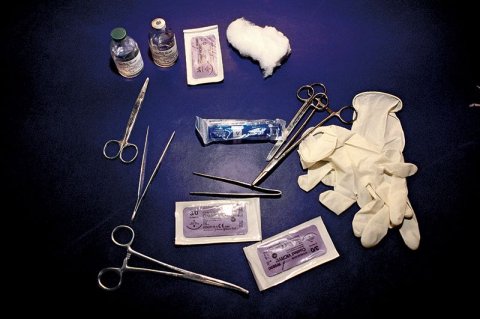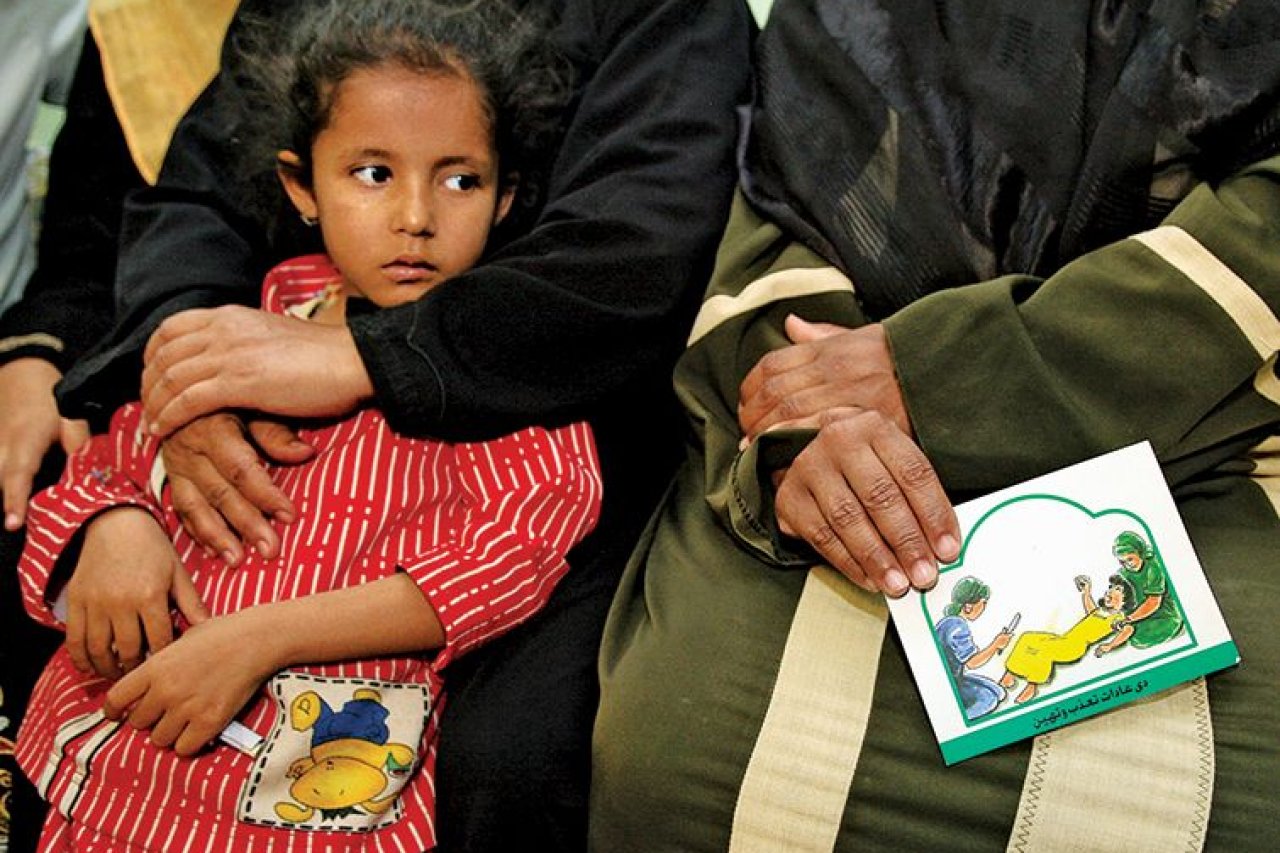The ghost that haunts Mansoura Mohamed's nightmares is an old lady dressed in black.
This apparition dates back to a summer in the late 1980s, in the village of Seflaq, Egypt. Summer is the season in Egypt for female genital mutilation (FGM); tradition states that when the dates on the palm trees turn red, it's time. Mohamed, just 7 at the time, and her three cousins were all cut on the same day. Her mother wanted her to go first, to show how committed their family was to the tradition. The cutter, an old woman and a daya, or traditional midwife, yelled and beat her as four women held Mohamed down in her father's house, while her mother waited outside. She remembers that there were a lot of towels and a lot of blood.
Today, Mohamed is 33. She still lives in Seflaq, with her husband, Ragab, and her 14-year-old daughter, Ghada. She is regularly visited in her sleep by the specter of the woman who cut her as a child. Ragab and Mansoura have chosen to spare Ghada from FGM, the removal of the external female genitals for nonmedical reasons. It's a decision that, though still atypical, is becoming more prevalent among young families in Egypt.
The country has the world's highest rates of FGM: 91 percent of married women, according to Egypt's 2008 Demographic and Health Survey (the last year for which data are available). Among younger and better-educated women living in urban areas, as well as those who never married, the rates drop—but only to around 81 percent. In Egypt, as in most of the countries in Africa, the Middle East and Southeast Asia where FGM is performed, it's a cultural tradition with roots going back centuries. Egypt stands out because of its large population: More women and girls from Egypt have been cut—27.2 million—than anywhere else in the world. "If we can eradicate this practice from Egypt, we can get rid of [more than] one-fourth of all cases worldwide," says Jamie Nadal, Cairo representative for the United Nations Population Fund (UNFPA).
The government is on board. In 2007 the Egyptian Ministry of Health issued a decree banning FGM; the following year Parliament criminalized the practice, establishing a minimum sentence of three months and maximum of two years, along with a fine. It's a start, and the hope is that the next Demographic and Health Survey, expected to be out this spring, will show FGM rates dropping.
Chastity From a Scalpel
Around the globe, an estimated 130 million women and girls alive today have undergone FGM, also known as female circumcision, and millions more are at risk of being cut, according to the UNFPA. Depending on the country, the practice can range from cutting off part or all of the clitoris to the total removal of the vaginal lips, and then sewing together whatever tissue remains. Some girls are cut when they are just a few weeks old, while others are made to undergo the process when they reach puberty.
The parents of these girls are often driven by the belief that they can make sure their daughters are "clean" and "pure." In many parts of the world, including Egypt, people believe FGM dampens sexual urges. Parents think it will translate into chastity, and give a daughter good manners to boot. The challenge is to transform the common fallacy that the clitoris is the dangerous root of sexual power into an understanding that it is an organ girls deserve to keep, and to convince Egyptians that a good daughter is the result of good parenting—not a mutilation.
FGM predates both Islam and Christianity: An ancient Egyptian tradition involved throwing the tissue-wrapped clitoris into the river and sacrificing it to the god of the Nile, according to Vivian Fouad, spokeswoman for Egypt's National Population Council. Yet many people still believe it's a practice mandated by the tenets of Islam. "[FGM is] a cultural practice that has been given a religious justification," says Rothna Begum, a researcher for the Middle East and North Africa women's rights division of Human Rights Watch. Begum says getting people to recognize that FGM is not a religious requirement can make all the difference. Which is why, she says, "in order for it to be tackled, you do need the religious officials on board."
Advocates are trying to enlist religious leaders to spread the message. Imams, bishops and priests have attended workshops at nongovernmental organizations (NGOs) and spoken to their congregations about how there is no religious basis for FGM. At the International Islamic Center for Population Studies and Research, part of Cairo's Al-Azhar University, a training program has been set up for Muslim religious leaders who will make preaching about the dangers of FGM a part of their weekly Friday prayers.

Health care workers are the next target: 72 percent of Egyptian girls who have been cut were cut by a doctor or other professional health care worker. Worldwide, one out of every five girls who undergoes FGM will be cut by a doctor, according to the UNFPA. Years of advocates speaking out about the health complications from FGM drove parents to the perceived safety of health professionals, says Dr. Khaled al-Oteifi, lead FGM coordinator at Egypt's Ministry of Health, but a recent landmark FGM trial provides stark evidence that the procedure can be deadly no matter who carries it out.
In June 2013, a 13-year-old girl, Sohair al-Batea, died from what is officially listed as an allergic reaction to penicillin after allegedly undergoing an FGM procedure in a private clinic northeast of Cairo. Egyptian media reported that al-Batea died from a sharp drop in her blood pressure resulting from anesthetic drugs given to her by the doctor, Raslan Fadl. Fadl turned himself in, claiming that he had done the procedure at the request of al-Batea's family, and that there was no medical wrongdoing. In January 2015, after a year and a half of legal proceedings, an appeals court in Mansoura convicted both Fadl and al-Batea's father of illegally performing an FGM. It was the first-ever FGM trial in Egypt.
It's hard to pin down the exact numbers of girls who, like al-Batea, die from FGM every year. Female circumcision is often performed under the guise of some other medical procedure, so it's impossible to get an accurate count—when a girl dies from an FGM procedure, it's almost always blamed on some other cause.
For doctors, especially those working in rural areas, there's a strong financial incentive to do FGMs, despite its criminalization in 2008. Doctors can earn up to $26 for one, much more than the $2.60 they can charge for a regular doctor's visit (although still significantly less than they can make for other specialty procedures—Lasik eye surgery, for example, costs about $655). Advocates say that in recent years doctors have begun making clandestine visits to villages, arriving at night and often under the guise of circumcising boys. "No doctor goes to circumcise a girl at 3 in the morning unless he knows he's doing something wrong," says Mona Amin, national project coordinator for the FGM abandonment and family empowerment program at Egypt's National Population Council.
There's no training for FGM in the country's medical schools, although the UNFPA is developing a curriculum for obstetricians and gynecologists that will have to be approved by the Egyptian Ministry of Health before it can be taught. Until then, the ministry is running a program to teach doctors what they didn't learn in school: that every part of the genitalia is a functioning part of the female body and that by performing the operation they violate human rights and medical ethics. It is also training doctors how best to explain to parents bringing in their daughters to be circumcised that there are harmful physical and psychological consequences.
The Cruelest Cut
Awatef Mohammed Ali is considering circumcising her 10-year-old daughter, Shahd. Recently, they sat together in a light purple room in the village of Bani Zeid el-Akrad, near Assiut in Upper Egypt. Shahd sat wide-eyed and fearful next to her mother, ignoring the paintings of Tweety Bird and other cartoon animals on the walls. Ali, who has attended anti-FMG workshops, says her daughter will be circumcised next summer, but the family will first consult a doctor, who will decide whether Shahd needs it. If the doctor says it will harm her, they won't do it, she says. Ali, who was circumcised, "doesn't want to stop the habit" of FGM, and her husband is determined to get his daughter cut.
Advocates in Egypt hope the practice will peter out as people start thinking of FGM as a crime rather than a tradition—and begin to more openly discuss the traumas associated with the practice. In many places, workshops are held to educate the community about the medical and psychological dangers of FGM. For example, at the Islamic Society Center, an NGO in Seflaq, women share their stories of childhood trauma in a windowless room. Ahlem Abdel el-Samen recalls the "black day, a very bad day" when she was cut at 10. Mary Labib Sweifi was 1 week old when she underwent FGM and doesn't remember a thing. Mariam Naeem Mossad, a Christian woman wearing pearl earrings and a long red and blue leather jacket, was 9; four women pinned her down. Mossad, who has an 11-year-old daughter, remembers seeing her mother constantly changing blood-soaked sheets. But she says the family tradition of FGM stopped with her. "Even if I had 100 daughters, I would not do it," she says.
On the walls of the center there are drawings of women on operating tables and childlike depictions of razor blades and blood. On a table, a white shawl embroidered with a pink flower and a pair of scissors serves as a constant reminder.
Travel and accommodations in Egypt for this story were paid for by the United Nations Population Fund.




























